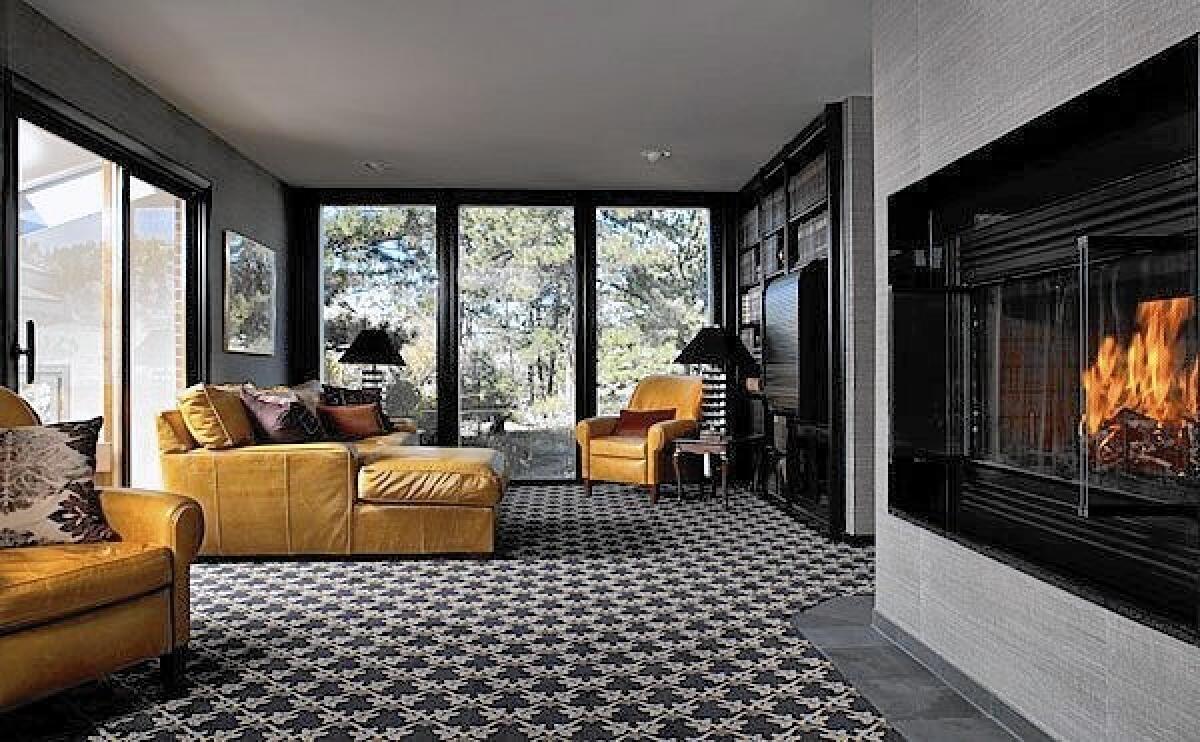Modifying interiors for older residents

- Share via
A high-tech kitchen with a magnetic induction cooktop that won’t burn a person who might accidentally touch it.
A refrigerator with extra lighting on shelves and drawers so food can be seen better.
Steps throughout the house that have lights between the tread and risers.
Rugs that are recessed to prevent slips and falls.
These are the housing accommodations that can help older people, who tend to have diminished olfactory and optical senses, balance problems and other physical limitations.
They are also features of the Colorado Rockies house that Cynthia Leibrock shares with her husband of 47 years, Frank.
Leibrock, an interior designer, author and educator, says the demand for quality living environments for the burgeoning population of older adults requires modifications to much of the existing housing stock. Changes need to be made in new construction today that will accommodate older residents’ needs in the future.
And interior designers are the problem solvers, she says.
The nation’s population is aging at a rapid rate. The U.S. Census Bureau says that by 2050, the number of Americans 65 and older is projected to be 88.5 million. That is more than double the projected population of 40.2 million in 2010.
Longer life spans and the baby-boomer bubble are largely responsible for the increase in the older population, but with new technologies constantly emerging, interior designers are focusing on making day-to-day life easier for the elderly.
Leibrock contends, however, that such adaptations shouldn’t just aim to improve the lives of older and disabled people. Everyone benefits from good design, she says.
Leibrock, who has over 35 years of professional design experience, spoke recently to students and faculty of the interior design program at Orange Coast College in Costa Mesa, discussing how to build environments with an aesthetic that is usable by everyone, regardless of age or physical or mental abilities.
Universal design, a movement promoting the idea that all structures, public and private, should be equally accessible to everyone, was coined by architect Ronald L. Mace, who helped develop the nation’s first accessible-building code.
The mission to improve the lives of older and disabled people through design became Leibrock’s pursuit when she didn’t find high-end residential design satisfying.
She had designed interiors for presidential homes and executive residences, “helping make rich people look richer,” she said.
Feeling frustrated, she decided to close her design business and let go of her employees. She then ended up going to a Bible study with one of the fired workers and discovered that her mission was to help the elderly and the disabled with interior design.
That purpose was tied to a personal connection.
Leibrock’s brother was diagnosed with schizophrenia when he had just finished high school. The family, she said, had no choice but to put him into an institution, where he faced several setbacks.
“People are not disabled by their physical differences,” Leibrock said. “We’re only disabled when we can’t do the things we want to do. Architecture can eliminate disability by design, and we, as designers, have the creativity skills to implement products and techniques where people are not segregated by design. We’ve had this separate-but-equal approach, and that’s not universal design.”
Leibrock went on to found Easy Access to Health, a Colorado-based firm offering consulting services in patient-centered design, plans for independent living and product analysis.
She has been involved in redesign projects for the Betty Ford Center, UCLA Medical Center and Toyota. She’s created a universal design exhibit for the Smithsonian Institution in collaboration with Julia Child and a showroom for the Kohler Co. so consumers can learn about the design concept.
Leibrock has served as a lobbyist for people with mental disabilities, and for the past 10 years has taught courses in the architecture department at the Harvard Graduate School of Design.
Today, she offers keynote presentations and workshops at universities that have interior design programs, and she offers fellowships at her Colorado home, called Green Mountain Ranch, to design educators who want to learn about universally designed products.
Renee Kubiak, interior design professor at Orange Coast College, was invited to take part in one of Leibrock’s educational retreats.
“I had the experience of my life,” Kubiak said. “We came with a single purpose and that was, ‘How do we contribute to universal design?’ It has to be educated through students. They’re the ones who are going to get into design firms and make those changes.”
Mary Jane Rumbley, a second-year interior design student at OCC, said she attended Leibrock’s lectures to learn how to implement aesthetically pleasing and helpful tools in residential homes.
“I realized universal design is just smart design,” said Rumbley, a Newport Beach resident. “It’s a way of presenting a design that has functionality and can support all people.”
With data from the U.S. Census Bureau estimating that 1 in 5 five adults in the U.S. will be over the age of 65 by 2050, Leibrock said the universal design focus stems from the notion that people can age in place. This solution to the aging crisis is fueled partly by the economic downturn, which has driven people to remodel rather than buy a new home.
Nothing in the house needs to look like contraptions in a hospital, Leibrock said.
Other ideas that Leibrock has developed include home thermostats that can be adjusted from the road, a wheelchair or a bed for people with reduced circulation; side-hinged ovens for an easier reach (“Who wouldn’t want that?” Leibrock asked); and video intercoms outside the home that can show images of a visitor and record a picture when the visitor has left.
Security is the number one issue for older people, she told the Orange County group.
“You’ll realize that this design is open to all,” Leibrock said. “When you come up with solutions, you are changing people’s lives.”
